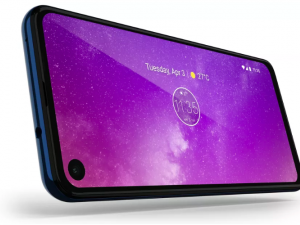Samsung Galaxy S10 Plus Review – Follow The Leader
Damien McFerran 12/03/2019 – 1:55pm
Is 2019's best Android handset already here?
£899.00
Every Galaxy S release creates a considerable amount of interest, but few have been as comprehensively leaked as the S10; weeks before Samsung officially lifted the lid on its 2019 flagship, we'd already seen what it looked like, what features it would boast and what accessories it would launch with. When the Korean firm eventually got around to confirming its existence just prior to Mobile World Congress 2019, it was something of an anticlimax – especially as the company also gave the industry a tantalising glimpse of the Galaxy Fold at the same time.
Even so, the S10 remains a vital release for the firm. With the S9 following in the design footsteps of the S8, the S10 is a new dawn for Samsung in more ways than one – not only does it mark the debut of a fresh design, but there's a new screen, innovative software and some other cool features. Is this the smartphone to beat this year? Read on to find out…
Samsung Galaxy S10 Plus Review: Design & Display

While the S10 Plus marks a new design era for Samsung, it hasn't ripped up the rulebook here. The same basic look that has characterised the Galaxy S range in recent years is retained, with the curved edges, metal frame and button placement. The bottom edge is home to the 3.5mm headphone jack (a real rarity these days), USB-C port and one of the two stereo speakers. The right-hand edge has the power button, while the opposite side houses the volume rocker and 'Bixby' button (which, you'll be pleased to hear, can be customised so you can launch a different app with it). The top of the phone has the SIM card tray and a noise-cancelling microphone.
Spin the device around, and you'll find a triple camera array accompanied by an LED flash on the back. Below this is the Samsung logo, and that's it; the rear of the S10 Plus is otherwise composed of featureless glass. The phone has an IP68 rating for water and dust resistance, too, in case you were wondering.
The front of the device is a whole other story. The Infinity-O screen really is something special, even if the 'hole punch' design has already been done on the Honor View 20. The fact that Samsung has crammed not one but two selfie cams in the aperture means it's not quite as elegant as Honor's solution, but it does at least make for some amusing wallpapers. Besides, it's not the hole that is the true talking point here, but rather the quality of the display itself.
The 6.4-inch QHD+ AMOLED panel offers a pixel density of 522ppi and is arguably the star of the show; we're not sure quite how Samsung does it, but each year it manages to improve its OLED screen tech to the point where yearly phone upgrades feel like totally new devices. The colours on this panel pop in a way we've never seen before, while the blacks are deep and wholly convincing.

Out of the box, the Galaxy S10 Plus is set to FHD+ resolution (2280×1080) but you can bump that up to WQHD+ (3040×1440) whenever you wish. To be honest, those extra pixels really aren't noticeable and it's not really worth doing when you consider it much additional strain it places on the hardware, but if you've got 4K movies to watch then you can at least be assured that the screen is giving you a native resolution experience.
The entire S10 range is compatible with Samsung's ageing Gear VR headset, which is good news for fans of mobile virtual reality. However, don't expect a visual upgrade if you're used to using the device with your S9 Plus; despite the additional pixels and wider screen, what you 'see' is exactly the same 1,280×1,440 per-eye resolution as before (this puts it on par with the Oculus Go, so it's not all bad).
If we were going to be picky, then we could point out that the screen – despite taking up 93 percent of the front of the phone – still has uneven bezels, with the ones at the top and bottom of the display being larger than those on the side. It's a really minor grumble though, given the otherwise impressive display.
The screen is hiding another secret – it's where the fingerprint scanner resides. Underneath the display is an ultrasonic reader which is pretty accurate and surprisingly fast. It's not quite as quick as a traditional fingerprint scanner and, despite using more advanced tech, felt like it was only a smidgen faster than the optical reader on the OnePlus 6T, but it's definitely a step forward to the rear-mounted scanner seen on the Galaxy S9, which was awkward to reach when the phone was resting face-up on a flat surface.
Samsung Galaxy S10 Plus Review: Software

Samsung's TouchWiz UI has been much derided over the years, and with good reason, you could argue; in the early days, it made the company's phones look like toys, and even in recent years, it has lacked the charm and grace that other OEM skins possess. We've heard more than a few people state that while Samsung's Galaxy range appeals on a purely physical level, the UI skin is what prevents them from making a purchase.
The good news is that Samsung has abandoned TouchWiz (which was renamed "Samsung Experience" in recent years, despite clearly still being TouchWiz) in favour of a totally overhauled user interface built atop Android 9. Named One UI, it marks perhaps the biggest change Samsung has made in terms of smartphone software since the original Galaxy S launched all those years ago – and the really good news is that the company has clearly thought long and hard about how people want to interact with their devices.
The most striking thing about One UI is how it's built to overcome the issue of massive phones with tall screens; Samsung has designed the menus so that all of the options are located in the lower portion of the display, where they can be easily reached with your thumb. It has also introduced iPhone-style gesture commands which feel so natural that once you enable them, you'll forget about those three traditional Android button commands in double quick time.

In terms of looks, the One UI has the same basic design as the old Samsung Experience, and we're not sure we like some of the icon designs the company has opted for; it all looks very basic when compared to many rival devices. Still, it's clean and easy to parse, and the ability to customise the look with themes and icon packs mean you can basically get the UI looking exactly how you want with very minimal effort.
What's rather less welcome is the fact that the Galaxy S10 Plus, like its forerunners, comes packed with apps which duplicate functionality already available in the Android space. Samsung has its own app store, which you'll end up having to use in order to update certain key Samsung-made apps – while also using the Google Play store due to the fact that it offers a much wider range of content. There's also Samsung Pay, the company's rival to G-Pay, and Samsung Health, which is in direct competition with Google Fit. And don't get us started on the fact that Samsung has signed a deal with Microsoft which means all of its phone ship with Office Mobile, OneDrive and LinkedIn pre-installed.
It's worth noting that Samsung isn't as bad for this kind of thing as it used to be, but the fact remains that most people will choose to use Google's apps when it comes to core functions. Companies like OnePlus are smart enough to know this and don't try to force the user to sign up for extra accounts in order to access stand-alone app stores. It's one of the most annoying things about Android in the modern era, and makes phones like the S10 Plus look bloated and confusing when compared to the iPhone, which relies on a single account to access all of its features, rather than two.
Samsung Galaxy S10 Plus Review: Performance

While much fuss has been made over the fact that the Galaxy S10 is one of the first phones to use Qualcomm's Snapdragon 855 chipset, that's not what we're getting here in the UK. As has been the case for ages, we've been blessed with Samsung's home-grown Exynos 9820 chip, which is a close match for Qualcomm's in pretty much every regard – although if you look really closely, the Snapdragon variant is actually the faster of the two.
In the Geekbench 4 test, the Snapdragon S10 Plus scored over 11,000, making it one of the most powerful Android devices money can buy. The Exynos version was around the 10,400 mark, which – while still respectable – is clearly lagging behind slightly. In day-to-day use, the difference really is negligible; in fact, unless you have both versions side-by-side, you're going to be none the wiser. Both versions are supported by 8GB of RAM.
It almost goes without saying that the Galaxy S10 Plus is faster than a greased whippet, and didn't bat an eyelid at any of the intense tasks we presented it with. 3D games, HD movies, rigorous multi-tasking… none of these things could put the S10 Plus off its stride. This really shouldn't come as much of a shock as smartphones reached something of a plateau in terms of everyday performance a short time ago, so each yearly update simply iterates on that. The S9 Plus was smooth as silk to use, so you may not even notice much of a difference with this newer model unless you really put it to the test.
One area where Samsung has made quite a significant stride is wireless data speed, thanks to the inclusion of Wi-Fi 6. Using this new tech, you can enjoy a speed boost of around four times over previous tech, although you have to have an updated wireless router to feel the benefit. While Samsung should be applauded for taking a step forward with this feature, we're not sure many people will really see an improvement over the next 12 months – especially if they're tied to companies like Virgin Media and Sky, who won't be rolling out compatible routers for a while yet.
Samsung Galaxy S10 Plus Review: Camera

The Galaxy S10 Plus comes with a 12-megapixel regular lens, a 12-megapixel optically-zoomed telephoto lens and new 16-megapixel ultra-wide lens. For those of you that are upgrading from the Galaxy S9 Plus, the first two snappers will be instantly familiar. The regular 12-megapixel lens comes with the mechanical 'dual-aperture' feature which improves low-light photography, while the telephoto lens is great for catching detail without having to resort to digital zoom, which almost always leads to a drop in quality.
While Samsung doesn't have a solid answer for Google's incredible low-light shooting mode on the Pixel 3, it does have one trick that's worth making a fuss about: that ultra-wide angle snapper. LG has previously used this kind of secondary lens on its flagship phones and to be perfectly honest, we're not sure why they're not standard on every smartphone these days.
Simply put, the ultra-wide lens fits more into the photo thanks to its 123-degree field of view, so group shots are a piece of cake. You can also take some amazing images when you're outdoors, fitting in more features into your image.
Samsung has also been hard at work on the software side of things, with features like Live Focus, Shot Suggestions and a fancy Scene Optimizer which uses AI to tinker with the snap and improve it in (mostly) meaningful ways. Live Focus – which is also available on Apple's phones these days – may not be big news anymore, but Samsung uses the feature for cool effects, such as the ability to have the subject in the foreground in colour, while the background of the image is in black and white.
But what of those front-facing cameras, the ones which have forced Samsung to introduce that large hole-punch in the top-right corner of the screen? The pair are 10-megapixel and 8-megapixel, and the reason they come in a pair is for Live Focus effects, just like the rear cameras. The effects look great, but not any better than those that companies such as Google and Apple are able to achieve using just a single lens and software. It's also worth noting that the front-facing camera setup no longer supports Iris Scanning, but does feature a 2D Face Unlock mode. This isn't as secure as Apple's 3D-mapping tech, but it works well enough.
Samsung Galaxy S10 Plus Review: Battery Life & Storage

A few people were disappointed that last year's Galaxy S9 Plus only had a battery capacity of 3,500mAh, and those moaners should be happy that the S10 Plus boosts that total up to an impressive 4,100mAh. No Galaxy S phone has had a power cell this large before.
Of course, that bigger battery is having to power a larger screen, so you'd expect a trade-off. Even so, the S10 Plus outperformed the S9 Plus in terms of stamina and was able to comfortably make it through an entire day, even when thoroughly put through its paces. Switch to the full resolution of the screen, however, and you'll notice the battery drops off alarmingly; while we're glad that display is so pin-sharp, it does rather beg the question: if you can't use it without draining the battery, what's the point?
It's also worth noting that the larger battery results in a rather protracted charging time, even when using Samsung's fast charge feature. Wireless charging takes even longer, even when using the company's 'fast wireless' system. It's not a deal breaker by any means, but just be sure to give yourself a little more time on the plug socket in those early morning rushes.

Elsewhere, we've got the new Wireless PowerShare feature, which basically turns the phone into a wireless charging pad. The company has marketed this function as a way of promoting its new Galaxy Buds wireless headphones, but it will actually work with any device capable of charging wirelessly – even rival handsets, like the iPhone XR.
It's a neat idea but one that we could potentially see causing problems; while the phone turns off PowerShare when your battery drops to 30 percent, you may wish to be careful about what kind of devices you top-up using this method. If your cheeky mate asks you for some power to get their handset up to 100 percent juice, it could leave you with hardly any battery life of your own. We'd argue PowerShare makes much more sense when used with accessories like the Galaxy Buds, which have a much lower capacity than your typical smartphone.
In terms of storage, the Galaxy S10 Plus comes with 128GB of space in the base model, but you can upgrade to either 512GB or 1TB if you're feeling flush. There's also a MicroSD card slot which accepts media up to 1TB in size.
Samsung Galaxy S10 Plus Review: Verdict

Samsung has pulled out all the stops with the S10, making it quite a dramatic statement in 2019 and surely one of the year's most promising phones. While it's hard to shake the impression that the smartphone sector is struggling for new ideas, Samsung has at least delivered a phone which excels in almost all areas. The screen is superb – perhaps the best we've seen on any phone – while the battery life and performance are also top-class. We absolutely love the ultra-wide angle camera, and while low-light performance isn't up to the standard seen in Google and Huawei's devices, it's still decent enough. PowerShare is also genuinely useful, and we can see it being adopted by other manufacturers as time goes on. It's also worth noting that the S10 range is compatible with the Gear VR headset, which makes it appealing to those who want a largely effortless route into virtual reality. All in all, the S10 Plus is a fantastic upgrade which ticks all of the right boxes, even if it doesn't shift the paradigm in the same way that its stablemate the Galaxy Fold promises to.
Review unit kindly provided by Mobile Fun.




